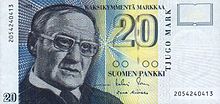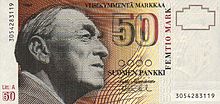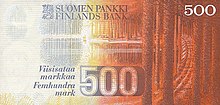사용자:이형주/핀란드 마르카
이 문서의 내용은 출처가 분명하지 않습니다. |
| 이형주/핀란드 마르카 | |
|---|---|
| 사용국 | {{{사용국}}} |
The Finnish markka (틀:Lang-fi, 틀:Lang-sv, currency code: FIM) was the currency of Finland from 1860 until 28 February 2002, when it ceased to be legal tender. The markka was replaced by the euro (€), which had been introduced, in cash form, on 1 January 2002, after a transitional period of three years when the euro was the official currency but only existed as 'book money'. The dual circulation period – when both the Finnish markka and the euro had legal tender status – ended on 28 February 2002.
The markka was divided into 100 pennies (틀:Lang-fi, with numbers penniä, 틀:Lang-sv), postfixed "p"). At the point of conversion, the rate was fixed at €1 = 5.94573 mk.
History[편집]
The markka was introduced in 1860 by the Bank of Finland, replacing the Russian ruble at a rate of four markka equal to one ruble. In 1865 the markka was separated from the Russian ruble and tied to the value of silver. After Finland gained independence in 1917 the currency was backed by gold. The gold standard was abolished in 1940, and the markka suffered heavy inflation during the war years. In 1963 the markka was replaced by the new markka, equivalent to 100 old units.

Finland joined the Bretton Woods Agreement in 1948. The value of markka was pegged to the dollar at 320 mk/$, which became 3.20 new mk/$ in 1963 and devalued to 4.20 mk/$ in 1967. After the breakdown of the Bretton Woods agreement in 1971, a basket of currencies became the new reference. Occasionally, devaluation was used, 60% in total between 1975 and 1990, allowing the currency to more closely follow the depreciating US dollar than the rising German mark. The paper industry, which mainly traded in US dollars, was often blamed for demanding these devaluations to boost their exports. Various economic controls were removed and the market was gradually liberalized throughout the 1980s and the 1990s.
The monetary policy called "strong markka policy" (vahvan markan politiikka) was a characteristic feature of the 1980s and early 1990s. The main architect of this policy was President Mauno Koivisto, who opposed floating the currency and devaluations. As a result, the nominal value of markka was extremely high and in the year 1990, Finland was nominally the most expensive country in the world.[출처 필요]
Koivisto's policy was maintained only briefly after Esko Aho was elected Prime Minister. In 1991, markka was pegged to the currency basket ECU, but the peg had to be withdrawn after two months with a devaluation of 12%. In 1992, Finland was hit by a severe recession. It was caused by several factors, the most severe being the incurring of debt, as the 1980s economic boom was based on debt. Also, Soviet Union had collapsed, which brought an end to the bilateral trade, and existing trade connections were severed. The most important source of export revenue, Western markets, were also depressed during the same time. As a result, by some opinions years overdue, the artificial fixed exchange rate was abandoned and the markka was floated.[1] Its value immediately decreased 13% and the inflated nominal prices converged towards German levels. Also, as a result, several entrepreneurs who had borrowed money denominated in foreign currency suddenly faced insurmountable debt.
The Finnish markka was added into the ERM system in 1996 and then became a fraction of the euro in 1999, physical euro money arriving later in 2002. It has been speculated that if Finland had not joined the euro, market fluctuations such as the dot-com bubble would have reflected as wild fluctuations in the price of markka. (Nokia, formerly traded in markka, was in 2000 the European company with the highest market capitalization.)
Names[편집]
The name "markka" was based on a medieval unit of weight. Both "markka" and "penni" are similar to words used in Germany for that country's former currency, based on the same roots as the German Mark and pfennig.
Although the word "markka" predates the currency by several centuries, the currency was established before being named "markka". A competition was held for its name, and some of the other entries included "sataikko" (meaning "having a hundred parts"), "omena" (apple) and "suomo" (from "Suomi", the Finnish name for Finland).
With numbers, Finnish does not use plurals but partitive singular forms: "10 markkaa" and "10 penniä" (the nominative is penni). In Swedish, the singular and plural forms of mark and penni are the same.
When the euro replaced markka, mummonmarkka "grandma's markka" (sometimes shortened to just mummo) became a new slang term for the old currency. The sometimes used "old markka" can be misleading, since it can also be used to refer to the pre-1963 markka.
In Helsinki slang, a hundred markka was traditionally called huge [hu.ge] (from Swedish hundra "hundred"). After the 1963 reform this name was used of one new markka.
Coins[편집]
When the markka was introduced, coins were minted in copper (1, 5 and 10 penniä), silver (25 and 50 penniä, 1 and 2 markkaa) and gold (10 and 20 markkaa). After the First World War, silver and gold issues were ceased and cupro-nickel 25 and 50 penniä and 1 markka coins were introduced in 1921, followed by aluminium-bronze 5, 10 and 20 markkaa between 1928 and 1931. During the Second World War, copper replaced cupro-nickel in the 25 and 50 penniä and 1 markka, followed by an issue of iron 10, 25 and 50 penniä and 1 markka. This period also saw the issue of holed 5 and 10 penniä coins.
All coins below 1 markka had ceased to be produced by 1948. In 1952, a new coinage was introduced, with smaller iron (later nickel plated) 1 and 5 markka coins alongside aluminium-bronze 10, 20 and 50 markka and (from 1956) silver 100 and 200 markka denominations. This coinage continued to be issued until the introduction of the new markka in 1963.
The new markka coinage consisted initially of six denominations: 1 (bronze, later aluminium), 5 (bronze, later aluminium), 10 (aluminium-bronze, later aluminium), 20 and 50 penniä (aluminium-bronze) and 1 markka (silver, later cupro-nickel). From 1972, aluminium-bronze 5 markka were also issued.
The last series of Finnish markka coins included five coins (listed with final Euro values, rounded to the nearest cent):
- 10 penniä (silver-coloured) - a honeycomb on the reverse and a lily of the valley flower on the obverse = 0.02 €
- 50 penniä (silver-coloured) - haircap moss on the reverse and a bear on the obverse = 0.08 €
- 1 markka (copper-coloured) - the Finnish coat of arms on the obverse = 0.17 €
- 5 markkaa (copper-coloured) - a lily pad leaf and a dragonfly on the reverse and a Saimaa seal on the obverse = 0.84 €
- 10 markkaa (two-metal coin, copper-coloured centre and silver-coloured edge) - rowan tree branches and berries on the reverse and a wood grouse on the obverse = 1.68 €
Banknotes[편집]
This section covers the last design series of the Finnish markka, designed in the 1980s by Finnish designer Erik Bruun and issued in 1986.
| Denomination | Value | Image | Main colour | Obverse | Reverse | Remark | |
|---|---|---|---|---|---|---|---|
| 10 markkaa | € 1.68 | 
|
Blue | Paavo Nurmi (1897 – 1973), athlete and Olympic winner | Helsinki Olympic Stadium | Discontinued upon introduction of the 20 markkaa note | |
| 20 markkaa | € 3.36 | 
|
Blue/green | Väinö Linna (1920 – 1992), author and novelist | Tammerkoski bridge | Introduced in 1993 | |
| 50 markkaa | € 8.41 | 
|
Brown | Alvar Aalto (1898 – 1976), architect | Finlandia Hall | ||
| 100 markkaa | € 16.82 | 
|
Green | Jean Sibelius (1865–1957), composer | Swans | ||
| 500 markkaa | € 84.09 | 
|

|
Red | Elias Lönnrot (1802–1884), compiler of Kalevala | Forest hiking trail | |
| 1000 markkaa | € 168.19 | 
|
Blue/purple | Anders Chydenius (1729–1803), priest and statesman | Kuninkaanportti gate in Suomenlinna | ||
| 5000 markkaa | Red/purple | Mikael Agricola (1510–1557), priest and linguist | Turku Cathedral | The note was never introduced. It was only a backup plan for inflation.[2] | |||
On this final banknote series, Bank of Finland used a photograph of Väinö Linna on the 20 markkaa note without permission from copyright holders. This was only revealed after several million notes were in use. The Bank paid 100,000 mk (€17,000) compensation to rights holders.[3]
The second-to-last banknote design series, designed by Tapio Wirkkala, was introduced in 1955 and revised in the reform of 1963. It was the first series to depict actual specific persons. These included Juho Kusti Paasikivi on the 10 markkaa note, K. J. Ståhlberg on the 50 markkaa, J. V. Snellman on the 100 markkaa and Urho Kekkonen on the 500 markkaa note (introduced later).
Unlike Erik Bruun's series, this series did not depict any other real-life subjects, but only abstract ornaments in addition to the person depictions. A popular joke at the time was to cover Paasikivi's face except for his ear and back of the head on the 10 markkaa note, ending up with something resembling a mouse, said to be the only animal illustration in the entire series.
The still-older notes, designed by Eliel Saarinen, were introduced in 1922. They also depicted people, but these were generic men and women, and did not represent any specific individuals. The fact that these men and women were depicted nude caused a minor controversy at the time.
Coins and banknotes that were legal tender at the time of the markka's retirement could be exchanged for euros until February 29, 2012.
See also[편집]
References[편집]
- ↑ Genberg, Hans: Monetary Policy Strategies after EU Enlargement. Graduate Institute of International Studies, Geneva, Switzerland, 2 February 2004. Accessed 7 February 2009.
- ↑ Kaartamo, Outi: Raha on kaunista. Helsingin Sanomat monthly supplement, April 2010, pp. 83-88.
- ↑ Luukka, Teemu (2006년 9월 27일). “Suomen Pankki maksoi korvauksia valokuvasta 17 000 euroa” (핀란드어). HS. 2006년 10월 2일에 확인함.
External links[편집]
- Overview of markka from the BBC
- Historical Finnish banknotes and coins at the Bank of Finland
- Main outlines of Finnish history-thisisFINLAND
- History of the Finnish Markka (1860-2002)
- Coins annulled on 1.1.1998
- Coins annulled on 1.3.2002
- Notes annulled on 1.1.1994
- Notes annulled on 1.3.2002
| 이전 러시아 루블 |
Finnish currency 1860년-2002년 |
이후 유로 |
